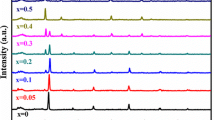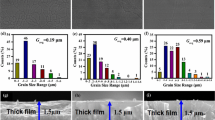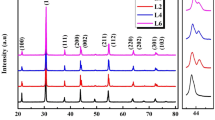Abstract
In this paper, (Pb0.98La0.02) (ZrxSn1-x)0.995 O3 (PLZS) antiferroelectric materials with different Zr/Sn ratios were fabricated by means of the rolling process, and the effects of Zr/Sn ratio on the phase structure and dielectric properties were systemically studied. All samples exhibited an orthorhombic structure. Furthermore, the results showed that the ABO3 phase structure could be easily formed when the Zr/Sn ratio was close to 1:1. The saturation polarization strength and the energy storage density increased with increasing Zr content, reaching peak value of 36 μC/cm2 and 9.5 J/cm3 at 0.49 and 0.55, respectively, and then decreased with a further increase of the Zr content. Besides, with increasing Zr content, the energy storage efficiency initially maintained a stable value of ~ 90% and then gradually decreased. The switching electric field of these materials was around 30 kV/mm and increased slightly with increasing Zr content. For all these samples, the dependence of dielectric constant on temperature varied similarly. A new intermediate state named “multicell cubic” appeared during the phase transition from the antiferroelectric phase to the paraelectric phase, which was different from the phase transition of traditional antiferroelectric materials. Moreover, the Curie temperature increased with increasing Zr content and then decreased. Based on the above result, PLZS AFEs could be a promising high-power energy storage material.







Similar content being viewed by others
References
Kittel C (1951) Theory of antiferroelectric crystals. Phys Rev 82:729–732
Sawaguchi E, Maniwa H, Hoshino S (1951) Antiferroelectric structure of lead zirconate. Phys Rev 83:1078
Jaffe B (1961) Antiferroelectric ceramics with field-enforced transitions: a new nonlinear circuit element. Proc Ire 49:1264–1267
Sawaguchi E (1953) Ferroelectricity versus Antiferroelectricity in the Solid Solutions of PbZrO3 and PbTiO3. J Phys Soc Jpn 8:615–629
Berlincourt D, Krueger HHA, Jaffe B (1964) Stability of phases in modified lead zirconate with variation in pressure, electric field, temperature and composition. J Phys Chem Solids 25:659–674
Dai X, Xu Z, Viehland D (1995) Phase stability and transformations in pure and lanthanum modified lead zirconate ceramics. J Appl Phys 77:5086–5094
Cai H, Yan S, Zhou M, Liu N, Ye J, Li S (2019) Significantly improved energy storage properties and cycling stability in La-doped PbZrO3 antiferroelectric thin films by chemical pressure tailoring. J Eur Ceram Soc 39:4761–4769
Qi X, Chen H, Deng B, Zhao J, Wei M, Gao L (2019) Energy-storage properties of Sr-doped PLZST bulk ceramics and thick films. J Mater Sci Mater Electron 30:17916–17922
Kainz T, Bitschnau B, Mautner FA, Reichmann K (2016) Comparison of lanthanum and bismuth modification of lead zirconate-lead titanate PZT—a structural and dielectric study. J Eur Ceram Soc 36:507–514
Zhang Q, Tong H, Chen J, Lu Y, Yang T, Yao X (2016) High recoverable energy density over a wide temperature range in Sr modified (Pb, La)(Zr, Sn, Ti)O3 antiferroelectric ceramics with an orthorhombic phase. Appl Phys Lett 109:262901
Jinfei W, Tongqing Y, Shengchen C, Gang L, Xi Y (2012) Characteristics and dielectric properties of (Pb0.97−xLa0.02Bax)(Zr0.72Sn0.22Ti0.06)O3 ceramics. J Alloys Compd 539:280–283
Ciuchi IV, Craciun F, Mitoseriu L, Galassi C (2015) Preparation and properties of La doped PZT 90/10 ceramics across the ferroelectric–antiferroelectric phase boundary. J Alloys Compd 646:16–22
Qiao P, Zhang Y, Chen X, Zhou M, Yan S, Dong X (2019) Enhanced energy storage properties and stability in (Pb0.895La0.07)(ZrxTi1-x)O3 antiferroelectric ceramics. Ceram Int 45:15898–15905
Bd A (1996) Transducers using forced transitions between ferroelectric and antiferroelectric states. IEEE Trans Sonics Ultrasonics 13:116–124
Jiang S, Zhang L, Zhang G, Liu S, Yi J, Xiong X (2013) Effect of Zr: Sn ratio in the lead lanthanum zirconate stannate titanate anti-ferroelectric ceramics on energy storage properties. Ceram Int 39:5571–5575
Wang X, Yang T, Shen J, Damjanovic D (2016) High-energy storage performance in (Pb0.98La0.02)(Zr0.45Sn0.55)0.995O3 AFE thick films fabricated via a rolling process. J Am Ceram Soc 99:3569–3572
Wang H, Liu Y, Yang T, Zhang S (2019) Ultrahigh energy-storage density in antiferroelectric ceramics with field-induced multiphase transitions. Adv Funct Mater 29:1807321
Breval EWC, Dougherty JP (2005) PLZT phases near lead zirconate: 1. Determination by X-ray diffraction. J Am Ceram Soc 2:437–442
Breval E, Wang C, Dougherty JP, Yilmazbayhan A, Gachigi KWA, Stewart M (2006) PLZT phases near lead zirconate: 2. Determination by capacitance and polarization. J Am Ceram Soc 89:3681–3688
Dan Y, Xu H, Zou K, Zhang Q, Lu Y, Chang G (2018) Energy storage characteristics of (Pb, La)(Zr, Sn, Ti)O3 antiferroelectric ceramics with high Sn content. Appl Phys Lett 113:063902
Dan Y, Zou K, Chen G, Yu Y, Zhang Y, Zhang Q (2019) Superior energy-storage properties in (Pb, La)(Zr, Sn, Ti)O3 antiferroelectric ceramics with appropriate La content. Ceram Int 45:11375–11381
Tan X, Ma C, Frederick J, Beckman S, Webber KG, Green DJ (2011) The antiferroelectric ↔ ferroelectric phase transition in lead-containing and lead-free perovskite ceramics. J Am Ceram Soc 94:4091–4107
Liu X, Li Y, Sun N, Hao X (2020) High energy-storage performance of PLZS antiferroelectric multilayer ceramic capacitors. Inorg Chem Front 7:756–764
Viehland D, Forst D, Li JF (1994) Compositional heterogeneity and the origins of the multicell cubic state in Sn-doped lead zirconate titanate ceramics. J Appl Phys 75:4137–4143
Viehland DFD, Xu Z (1995) Incommensurately modulated polar structures in antiferroelectric Sn-modified lead zirconate titanate: the modulated structure and its influences on electrically induced polarizations and strains. J Am Ceram Soc 78:2101–2112
Acknowledgements
This study was funded by the National Natural Science Foundation of China (Nos. 51872202, 51472181).
Author information
Authors and Affiliations
Corresponding author
Ethics declarations
Conflict of interest
There is no conflict to declare.
Additional information
Handling Editor: Till Froemling.
Publisher's Note
Springer Nature remains neutral with regard to jurisdictional claims in published maps and institutional affiliations.
Rights and permissions
About this article
Cite this article
Liu, Y., Liu, S., Yang, T. et al. Achieving high energy storage density of PLZS antiferroelectric within a wide range of components. J Mater Sci 56, 6073–6082 (2021). https://doi.org/10.1007/s10853-020-05720-1
Received:
Accepted:
Published:
Issue Date:
DOI: https://doi.org/10.1007/s10853-020-05720-1




